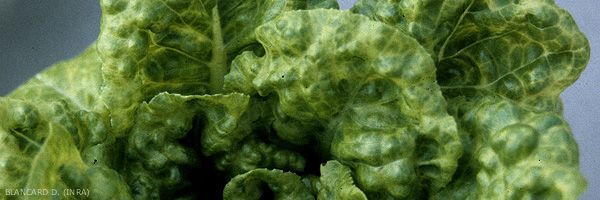
Lettuce mosaic virus (LMV)
- classification : Potyviridae, Potyvirus
First reported in the United States (Florida), then in Europe, the lettuce mosaic virus (LMV) has now been identified in all regions where lettuce is grown, from the most common areas. northern to the hottest areas.
In the open field , it remains the major virus in countries where the production and use of controlled seeds "virus-free" have not been generalized among professionals. The same is true in countries where resistant varieties are not available. Serious epidemics can occasionally be observed locally when susceptible varieties are cultivated, despite the use of healthy seeds. This situation may be due to changes in the management of the cultural environment, such as, for example, the introduction or imperfect control of plant reservoirs of the virus.
In production areas where resistant varieties are grown, the emergence of virulent strains bypassing the genes used can also lead locally or regionally to serious damage. The frequency of LMV is generally low in crops under cover.
LMV is one of the most serious viruses affecting lettuce (Figure 1). It is transmitted by seed in this species and also infects escarole and curly chicory. There are many strains which differ from each other by their biological and serological properties. For example, very aggressive strains have been isolated from wild compounds, such as Helminthia echioides (Picris), but also from chicory and lettuce.
 |
| Figure 1 |
For several years, strains capable of bypassing the resistance gene (s) most used in breeding ( gene mo1¹ , eg " g ", in France and in Europe, mo1² , eg . " mo ", in the United States) have been isolated in many countries. A molecular characterization of the variable regions of the genome of this virus made it possible to establish phylogenetic relationships in about twenty isolates which were divided into three groups.





